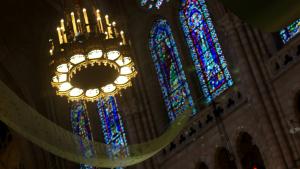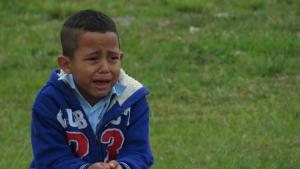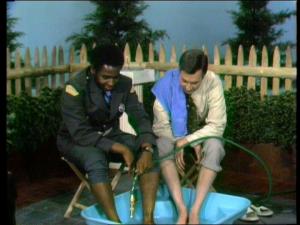One Riverside: Believe
Mark 12: 38-44
 Happy birthday, Riverside Church! We’re at the start this morning
Happy birthday, Riverside Church! We’re at the start this morning
of a whole day of celebration commemorating 85 years of mission and ministry in this place. What a gift we have been given, inheritors of such an incredible legacy of faith and witness…
…and what a challenge we have before us, living into the promise of what God is calling us to do and be in this place.
Today is also week two in a three week stewardship emphasis, where we’re looking at the assigned texts for the week and thinking in specific terms about our call to live into a strong, unified, collaborative community of faith:
One Riverside, in which we create a radically welcoming place of belonging; where we learn more deeply everyday what it means to believe the gospel message; and where we embrace the opportunity to become God’s best dreams for our own lives, and part of creating the world God envisions for us all.
Today we’re exploring the opportunity we have to invest in a community of faith that institutionally reflects the radical gospel message and works at an excellent level to form disciples who have the courage to live lives of radical defiance to the ways of this world…not the kind of religion we see so often, the kind that hurts and excludes, but the kind of religion that the book of James describes as religion that looks after orphans and widows in their distress and teaches us to keep ourselves from being polluted by the world.
A daunting task, if you ask me.
Yet, if a pastor were called upon to preach a sermon during stewardship season on, say, a notable church anniversary, a sermon that would call the people to radical investment, you’d think that that preacher would be jumping up and down for joy upon discovering that the gospel lectionary text assigned for the day is a classic stewardship text, one that has been used since it was written down, I expect, to call people of faith to selfless giving. It’s a little passage in the gospel of Mark, two short paragraphs that seem unrelated but which we’re assigned to read together this morning.
We know, of course, that it’s always a mistake to look at scripture passages out of context, so to understand this one we have to remember that right before this passage starts Jesus is preaching in the temple, calling the religious machinery to task for imposing crippling rules masquerading as true religion, rules that exclude and oppress people. Jesus’ famous call to the most important rule of all: loving God and loving neighbor, in fact, comes immediately before this passage.
In the first paragraph of today’s text, we encounter Jesus winding up the sermon I just mentioned by calling out the scribes and temple leaders who walked around for the purpose of being seen, who came to the temple and, indeed, practiced religion for status and popularity.
Then, having finished a sermon that I’m sure Jesus knew would get him into trouble, it seems he went out into the temple courtyard to take a break.
I feel you, Jesus…preaching is exhausting!
And while he was sitting there with his disciples, the text says that he started watching the multitude put their offerings into the treasury.
Apparently back then they didn’t do the offertory like we do it now. No discreet passing of the plates while a soft organ piece plays. No finely-tuned and choreographed usher board managing logistics. Out in front of the temple, right out in front of God and everybody, there was a big metal container. The container was shaped like the horn on a tuba—a big metal funnel-like object. Think of those plastic discs they have in the shopping mall—put out there by non-profits trying to solicit donations. You put your money in and it takes a long time, going around and around until it finally goes down. It was the same principle, except there was a loud sound component to this type of giving. You could not help but overhear what was going on.
How convenient it was, then, for those who had a lot to give! No paper money in those days, only coins, so you can imagine that if I had a lot to give, I could dramatically approach the treasury container, weighed down with all those coins I am carrying, and then throw all those coins in, with a whole bunch of force—clang, clang, clang. Naturally, everyone around would turn with admiration at the generous display of sacrifice . . . . The temple treasury was a convenient place to make giving a social event, and believe me, everyone knew what was going on.
Well, this was the backdrop to Jesus’ and the disciples’ conversation that day, which made it even more easy to overlook a widow, the lowest of the low, the rock bottom of the social strata, slip in among the crowd and drop her two coins into the temple treasury. They were very thin, archeologists tell us, made of copper, together not even worth one cent. And they certainly didn’t set the treasury clanging. They probably just slid quietly down the side. There was no reason for that woman to make a big show of giving her two coins; nobody would be impressed anyway.
Nobody, that is, except Jesus. He pulled his disciples to the side and said, “You see that widow?”
Can you imagine their response?
“Widow? What widow? I was still thinking about the scribes. I was still trying to listen intently to see who was giving the biggest offering, you know…like you do at temple…!”
Jesus said, “Believe me when I tell you that this widow has given more than anyone else here this morning, in fact, more than all the contributors to the treasury put together.”
And, there we have it—the perfect set up for a stewardship sermon. Except…except this passage doesn’t really work all that well for a stewardship sermon, if you think about it. On the one hand, you could read this story and argue that it doesn’t really matter how much you give because Jesus complimented the widow, who gave so little. Or, you could argue that giving part of what you own isn’t enough—we should all give everything we have. You could manipulate the passage, stretch it a bit here and there, use creative license to make it work, for sure. But truthfully, there’s no direct financial application for us here, and the disciples were as confused as we are.
I imagine them looking at each other, brows furrowed, wondering, “Did I miss something? How come I can never figure out what he is talking about?”
Jesus was perpetually turning things on their heads, and this little passage is no exception. We can see why today if we read just a little further.
Right after Jesus notices the widow, he gets up to leave the temple. When one of his disciples comments on the impressive architecture of the building, Jesus talks bluntly about the destruction—the destruction—of the temple.
Turns out, Jesus isn’t really talking about money after all. He’s talking about religion, organized religion, the institutions and communities we build to reflect God’s work in the world. And he’s inviting us to pay close attention to what makes for good religion.
Because even back then there was a lot of bad religion out there, and Jesus, frankly, wanted none of it. No posturing or showing off. No valuing prestige or prominence. No providing a platform to exalt the already influential and wealthy, all the while crippling the poor and marginalized with rules enforced by guilt and shame.
No more of that.
Good religion cares for orphans and widows and helps us keep from being polluted by the world…good religion forms disciples who, in the rigor and wonder of community, grow into people who love God with their whole lives and who love their neighbors as themselves. That kind of community is rare to find and difficult to nurture because the world pulls us away, over and over again, luring us with the temptation those prominent temple-goers faced as they hurried to hear the clanging satisfaction of their coins in the public offering canister.
The work of building community where people are invited to believe in the life-changing message of the gospel, that radical love that Jesus was always talking about, that kind of community is worth our lavish investment. And perhaps that kind of community…this kind of community…is one of the best things in which we could ever invest our lives, our talents, our financial resources…because as we work together to form disciples in the way of Jesus, one by one, we are changing lives…and we are changing the world.
Imagine that you have recently found yourself at the helm of a radical religious experiment, a beautiful cathedral in the middle of Manhattan built, with every little detail, to display the “beauty of proportion and perspective, of symbolism and color,” inviting everyone who encountered the space to “bring before God the best offerings of the human spirit…”?
On the very first Sunday of worship in that new space 85 years ago, the New York Telegram reported, “A crowd so great that when the last pew was filled a huge queue still half encircled the building…only 2,500 obtained seats in the nave and galleries. Another 800 were given seats in the basement, where amplifiers projected the sermon.” The audience included many prominent people in Manhattan society, but also “persons from every walk of life, every nationality, race, faith, denomination and creed.” Many foreigners, neighbors across the park at International House, plus workmen who had built the church—masons, plumbers, stone cutters, electricians, wood carvers…” filled the sanctuary.
As the incredible crescendo of a new hymn, written especially for the occasion, soared through the arches of the nave, worshippers could look around and see eight red lights, just above the chandeliers, and the stained glass windows through which light flooded the sanctuary—beauty and color “that could hardly be matched in a city renowned for its beautiful churches.”
Were you the pastor that day, called upon to speak to the care and stewardship of such a community, what would you say?
It seems that Harry Emerson Fosdick, founding pastor of this church, took a page from Jesus’ playbook that day and decided he would talk about…good religion.
Fosdick explained his dream to be part of creating a community, and institution in which people might encounter Christ in such a way that their lives and this world were transformed by true discipleship, the work of the gospel, true religion.
Churches—people who call themselves followers of Christ—can distort religion, as Jesus noted the scribes and Pharisees doing at the temple that day. Jesus would insist, as Fosdick pointed out, that we create and nurture communities that form disciples in the way of Jesus.
What builds a community of true religion, like Jesus taught? What builds a church like that? Hear Dr. Fosdick’s words:
“To see that this world is not the child of chance and the sport of atoms, that God is over all and in all and, ahead of us, hope like a sun forever rising and never going down—that does it.
To find within ourselves spiritual resources, like wells with deep springs…—that does it.
To walk in a divine companionship so that across the years a man grows inwardly like the Christ he lives with and achieves dependable and useful character—that does it.
To find life’s meaning not so much in the things that serve us as in the spiritual causes we serve, so that by identifying ourselves with something greater than ourselves we live expanded lives and leave behind us a fairer world—that does it….
What if we could build here a church which would say, so that men would have to listen: nothing matters in Christianity, however long the traditions or accumulated the sanctities,–not creedal codes or denominational partisanships or ritual regularities,–nothing except those things that create abundant life…without them no life can be beautiful and no civilization secure.”[1]
As we spend today celebrating a legacy of forming disciples in this place, of helping people encounter Christ and come to believe in such a way that their lives are transformed, may we hear again the words of Jesus calling us to invest with all that we have and all that we are in the creating a place where true religion is lived out everyday.
Be disciples. Make disciples. This community is doing that—true religion, and worth the investment of your time, your money, your talent…your whole life.
Friends, what if we could build a church that showed the world that the trappings of religion are worth nothing, unless we are a community at work forming disciples in the way of Jesus?
I believe with God’s help, we can do it. Happy, happy birthday, Riverside Church.
Amen.
[1] “What Matters in Religion,” a sermon by Harry Emerson Fosdick delivered at the first worship service held in the nave of The Riverside Church, October 1930.











